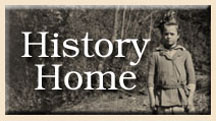

Pi Beta Phi Health Care Program: Page 2
Higinbotham’s efforts received a tremendous boost when, in 1922, the
fraternity opened its much-anticipated rural public health clinic--dubbed
the Jennie Nicol Memorial Health Center in honor of Pi Beta Phi founder Jennie
Nicol--in a renovated cottage on the Settlement School grounds. From the clinic,
Higinbotham provided a variety of medical services to Gatlinburg residents
and Settlement School students: physical examinations, inoculations, first
aid to the injured, and free clothing and medical supplies for those in need.
The JNMHC also provided her with a platform from which to educate her new
neighbors about the benefits of personal hygiene and preventative health care.
By the time Higinbotham resigned her position in 1926, Gatlinburg residents,
as well as people from as far away as Sevierville, had grown accustomed to
looking to the JNMHC in times of medical crisis. Settlement School alumnae
Lucinda Oakley Ogle perhaps spoke for all Gatlinburg residents when she stated
that “Miss Phyllis . . . [was] a God-send for the mountain people.”
Following Higinbotham’s resignation, the settlement school saw several
nurses come and go in rapid succession. It was not, in fact, until 1935 that
Pi Beta Phi acquired the long-term services of Illinois native Marjorie Chalmers,
a dedicated nurse (although not a Pi Phi) who would preside over the settlement
school health program for the next thirty years.
Unlike Higinbotham, Chalmers had an easier time locating and treating her
patients. Possessed of a car, and of a rather profound sense of daring, “Miz
Marjorie” spent countless days and nights clattering and bumping along
over the region’s poor roads, doing her best to dodge rocks and stumps,
and to avoid tumbling over the occasional precipice. Fortunately for her,
Gatlinburg mechanics made a priority of repairing her cars. “The boys
at the garage watched over these cars with a very personal interest,”
she wrote in her autobiography Better I Stay, “for no one knew when
they might carry them or one of their folk on a fast emergency trip.”
It was, incidentally, during Chalmer’s tenure that the settlement school
health care program realized its primary objective: convincing Gatlinburg
residents to abandon their reliance on folk remedies and purely curative care,
and instead move towards a reliance on preventative measures such as inoculations
and good personal hygiene. Where once, new and expectant mothers sought the
advice of “Granny Women” (midwives) as it regarded birth and infant
care, they now brought their concerns to the JNMHC; where once, fearful parents
refused to allow their children to receive inoculations, they now lined their
youngsters up at the JNMHC on appointed days. Furthermore, in most cases,
children born with birth defects received the treatment so often denied them
in the pre-Pi Beta Phi days. And rare was the child who, known to the settlement
school staff, went long without receiving eye and ear examinations (and corrective
work or glasses in the event that they were needed). So improved were Gatlinburg
children’s hygiene standards, in fact, that they regularly took top
honors in Sevier County’s “Blue Ribbon Day,” personal health
and hygiene program.
Like all good things, however, the Pi Beta Phi Settlement School’s Health
Program eventually outlived its usefulness. Sevier County took over financial
responsibility for public health in Gatlinburg in 1965, relieving the fraternity
of the need to provide further funding and enabling Nurse Chalmers to embark
on a well-deserved retirement. In the end, the program had succeeded beyond
everyone’s expectations, garnering accolades from state health officials
and Gatlinburg residents alike. Truly, it was one of the Pi Beta Phi Settlement
School’s greatest achievements.
| <<< Page 1 | Page
2 |
 |
|